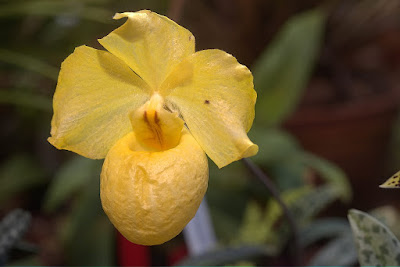The Apricot Orange Paphiopedilum is native to in inaccessible areas of south-western China, near Bijiang, in the western province of Yunnan. Plants grow on limestone hills and cliffs in forests above the Salween River (Nujiang) at the north-eastern border with Burma at 26.5 ° north latitude. Paphiopedilum armeniacum grows at an altitude of approx. 2000 m in the midst of rocks, in semi-shady mountain forests. The nearest meteorological station is approx. 150 km away. It is located above the same river valley at a similar height.
Paphiopedilum armeniacum orchid, also called as The Apricot Orange Paphiopedilum, Paphiopedilum armeniacum f. markii, Paphiopedilum armeniacum var. markii, Paphiopedilum armeniacum var. mark-fun, Paphiopedilum armeniacum var. parviflorum, Paphiopedilum armeniacum var. undulatum, is a species of the genus Paphiopedilum. This species was first described by S.C. Chen & F.Y. Liu in 1982. The name of the plant, despite appearances, has nothing to do with Armenia. In Latin, "armeniacum" means "peach". This name, however, is not adequate to the real - canary - yellow color of flowers.
IDENTIFY PAPHIOPEDILUM ARMENIACUM ORCHID
The Apricot Orange Paphiopedilum is native to in inaccessible areas of south-western China, near Bijiang, in the western province of Yunnan. Plants grow on limestone hills and cliffs in forests above the Salween River (Nujiang) at the north-eastern border with Burma at 26.5 ° north latitude. Paphiopedilum armeniacum grows at an altitude of approx. 2000 m in the midst of rocks, in semi-shady mountain forests. The nearest meteorological station is approx. 150 km away. It is located above the same river valley at a similar height.
It is a small, warm to cool growing, terrestrial species found on limestone cliffsides in humus with semi shade, they have distichous, 5 to 7 oblong, obtuse to acute, apically serrulate, dark and lighter green mottled leaves (10-15 cm in length) and purple spots beneath, that has an erect, 25 cm in length, green, pubescent, and spotted purple inflorescence with lanceolate-ovate, acute floral bracts that gives rise to a single, thin textured flower in the winter and early spring that is held above the leaves and was discovered only in 1982.
This plant blooms on a terminal, erect, single flowered inflorescence with a lanceolate-ovate bract in spring and summer on a compact plant, which is often dwarfed by the size of the flower. Large, rounded, uniformly yellow flowers are beautiful and unique in this type. This plant is attractive even when it does not bloom, which does not happen with many orchids.
GROW AND CARE PAPHIOPEDILUM ARMENIACUM ORCHID
Cultural information should only be used as a guide, and should be to be adapted to suit you. Your physical location; where you grow your plants, how much time you have to devote to their care, and many other factors, will need to be taken into account. Only then can you decide on the cultural methods that best suit you and your plants.
Light:
It is one of the most demanding Paphiopedilum for light. 18000-20000 lux are needed for your well-being. However, it should not be exposed to direct sun, a rather bright, diffused light is the best. Strong air movement should be provided at all times, and plants thrive when placed in the strong, cool, moist airflow near the outlet of an evaporative cooler.
Temperature:
It is an intermediate-cold greenhouse species. The average temperature of the summer day is 23-24 ° C, night 16-17 ° C, which gives a daily amplitude of 7-8 ° C. The average temperature of the winter day is 15-16 ° C, and the night 0-2 ° C, daily amplitude 14-15 ° C. If it is not possible to guarantee the night temperatures so low, they must however be at most on 8-10 ° C.
Humidity:
80-85% in summer and early autumn, decreasing in winter and at the beginning of spring to 60-65%. Being cultivated in pots, Paphiopedilum armeniacum orchid grows well even with 55-60%. However, if the humidity drops below 45%, the plant suffers.
Substrate and growing media:
The substrate, however, must be vaporous enough to allow the roots to breathe. In particular, the roots of the Paphiopedilum armeniacum are very sensitive to accumulation of mineral salts in the substratum and to stagnant water: the presence of the last destines the plant to death. Considering all that, the ideal substrate is the medium-sized bark (2-4 cm), with a possible addition of chopped shells to increase the alkalinity of the substrate. Some add a bit of sphagnum, but I would advise against it: the sphagnum creates an acid environment, absolutely not liked by the Paphiopedilum armeniacum.
Watering:
During the growing period (March to October) this species gets water when the substrate becomes almost dry. In winter it is essential to provide the plant with the conditions in which it could rest: low temperatures and little water. The watering is replaced by light daily spraying of the superficial part of the substrate. When the temperatures rise, the watering increases gradually. In the meantime the orchid should begin to produce floral stems or new jets.
Fertilizer:
Paphiopedilum armeniacum is fertilized every 3 watering with 1/4 of the dose indicated on the vial of a suitable liquid fertilizer for orchids. The fertilizations occur only during the period of growth. While the plant is at rest, the fertilizations are completely suspended.
Rest period and repotting:
The literature states that plants grown in warm conditions without a resting period can suddenly die out for no apparent reason. Therefore, they should be provided with at least 1-2 months of significantly lower temperature (approximately 10 ° C). The rest period lasts 2-3 months, from the end of November to the end of January / mid February.
Plants may be repotted at any time, but it is usually done in spring immediately after flowering. This gives the plant a chance to recover and become established before the stress of summer heat. By repotting this species, we must be careful not to leave the root base exposed to the air.















COMMENTS